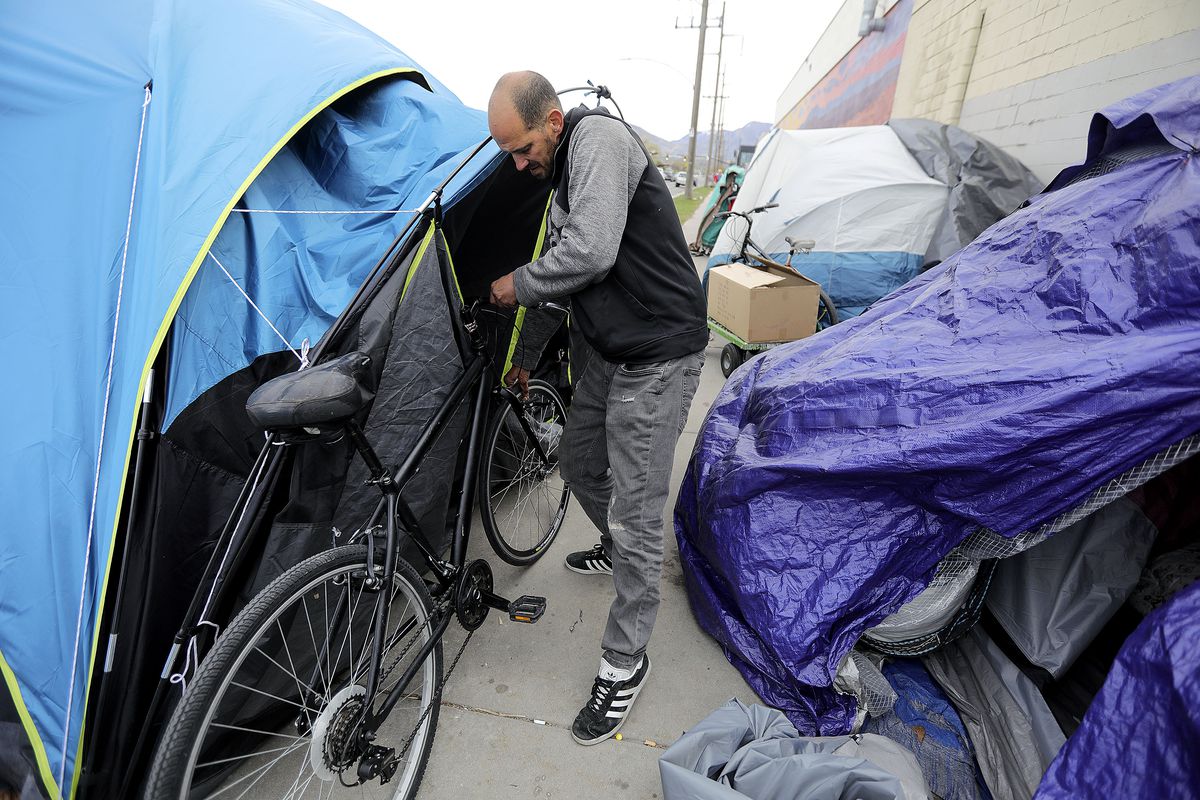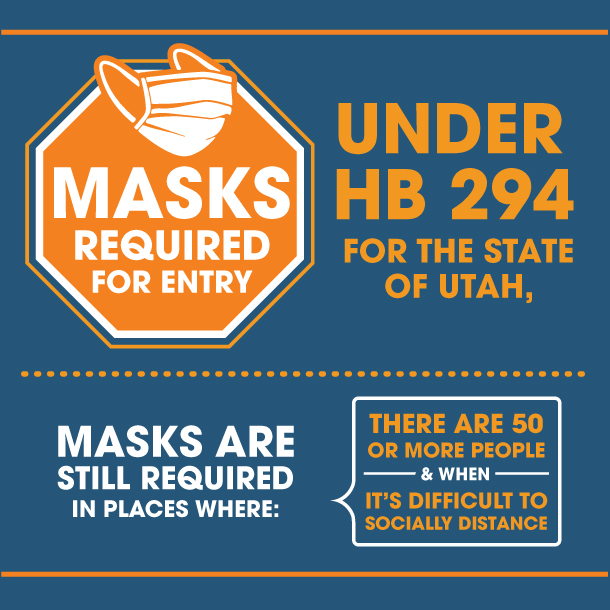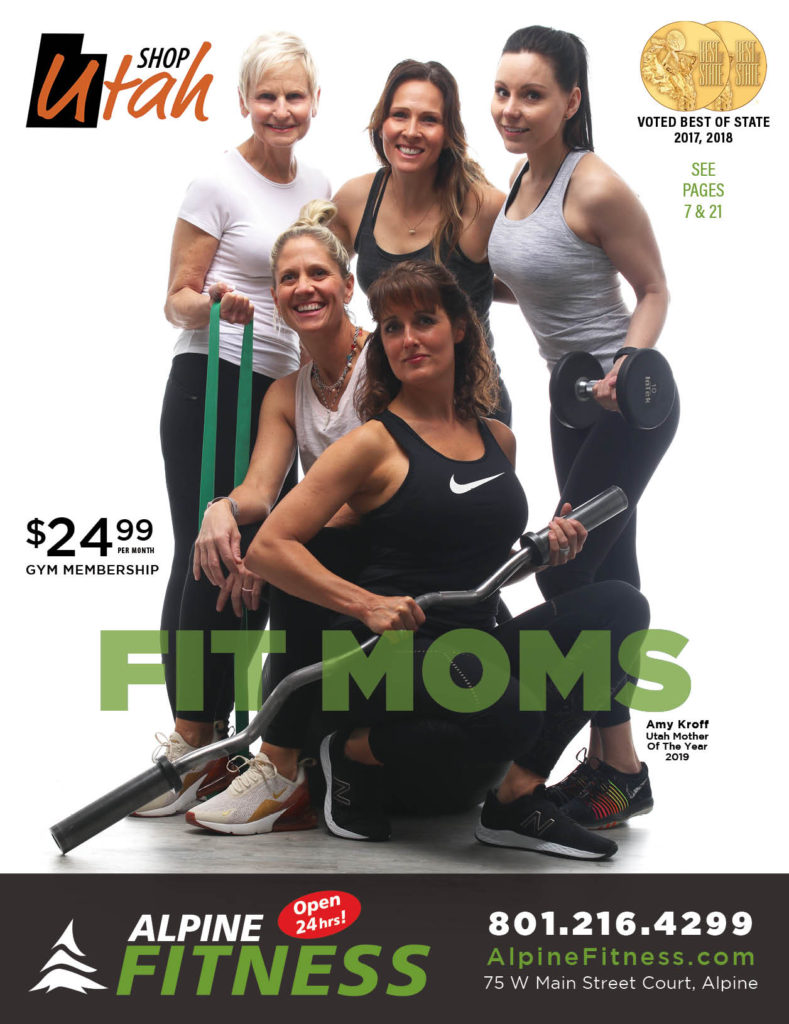PROVO, Utah – When a sudden gust of wind lapped at a tent propped up on the sidewalk, Andrew Blackburn jumped to save a bike that was leaning against it and had toppled over.
A storm was blowing in, with strong winds forecast for the Salt Lake area that night. The tents nestled on the sidewalk — beneath murals representing the faces of people killed by police painted on the sides of buildings in an industrial area named the Fleet Block — were about to be put to the test.
“You always look after your neighbors,” Blackburn said, steadying the bike upright.
But the tents that survived the winds were cleared out anyway the following morning. On April 14, Salt Lake County crews completed another one of their homeless camp sweeps in what has become an ongoing Band-Aid solution to address on-street camping, its health hazards and the aggravation it causes residents and businesses.
The cleanups are not without warning, offering time enough for residents to move on. But they are a lightning rod for activists who see themselves as defenders of Utah’s homeless and consider on-street camping as the only resort for those who aren’t finding — or are not accepting — the help they need from the Salt Lake Valley homeless system.
That Band-Aid is still in use even after the creation of three new centers to help the homeless that cost more than $63 million to construct and took a major investment of political will from Salt Lake city and county mayors, preceded by years of painful not-in-my-backyard debates to even just site the facilities.
It’s been over a year since all three of Utah’s new multi-million dollar homeless resource centers opened their doors, not long before the COVID-19 pandemic hit and complicated everything. They were envisioned as a major, needed step to improve Utah’s homeless system.
Are they working as intended and as hoped? If so, why are so many people experiencing homelessness still living on the streets? Is this what success looks like or are they failing? Or are the problems they’re facing much bigger than the centers themselves?
Ending up on the streets
Blackburn, 44, who grew up in suburban Sandy, said he’s been living on the streets of Salt Lake City for about a year. He’s struggled to get back on his feet after losing his job in construction not long after the COVID-19 pandemic hit. Then he said he lost his car for not being able to pay for insurance.
“Everything’s just kind of slammed,” he said, adding that he hasn’t had much help from family. “When you don’t have family, you really don’t have anything.”
It’s been a perfect storm of problems for the past year, Blackburn said. While he’s struggled to find another job, he said what’s mattered most to him is being with his wife.
That’s one of the main reasons Blackburn says he’s stayed out of Utah’s new homeless resource centers that opened in 2019.
Their openings capped a major shift in serving the homeless, moving away from the centralized, downtown Road Home emergency shelter that at times sheltered more than 1,000 people, with no firm bed cap.
The Rio Grande neighborhood around the shelter became so overwhelmed by outdoor camping and open drug use, state leaders stepped in and launched the controversial Operation Rio Grande in 2017 to clean up the area and pave the way for the closure of the downtown shelter. It was replaced by the three new, smaller, more scattered, service-focused homeless resource centers with higher barriers of entry (they require metal detectors and bag checks before entering).
“I don’t do the shelters,” Blackburn said, saying husbands and wives are “separated” when they go into the centers. While the Gail Miller Resource Center is for both men and women, they have separate sleeping areas.
“So a lot of people I know would rather stay on the streets because of that.”
So despite the efforts of the past 3 1⁄2 years, tents have returned to Rio Grande. They’ve also cropped up throughout the city, often cycling in and out of central Salt Lake City areas including Taufer Park or the Fleet Block, where Blackburn and his wife had pitched their tent, depending on when the next county cleanup is planned.
The reasons why those camping on streets or in the foothills avoid the new homeless centers vary just as much as their individual stories. Some are turned off by the rules. Some say it’s difficult to be at the centers on time so they don’t lose their beds. Some are in the throes of drug addiction, and drugs aren’t allowed inside the centers. Some say they prefer the autonomy of outdoor living. Amid the pandemic, fears of COVID-19 drove many away from congregate living.
Complex problem, complicated outcomes
As Utah’s political players look back on what has and hasn’t changed, they say the new centers have absolutely been a positive “step” and have helped transform the way the homeless get help. They see them as an improvement from the warehouse-style downtown shelter, but also acknowledge there are still gaps in the overall system.
Still, officials say they were never supposed to be the end-all solution to homelessness in Utah.
“If anyone had thought the building of the resource centers was the end game, they were wrong and they were naive,” said Salt Lake County Mayor Jenny Wilson.
So is the new system to combat homelessness actually working as intended?
Well, it’s complicated.
- It’s working in the sense that more than 700 individuals have been diverted from entering shelter in the first place.
- It’s working in that it helped more than 900 people into housing last year, according to Shelter the Homeless, the nonprofit that owns the facilities.
- And it’s working in the sense that shelter and case management has helped thousands of those in need.
It’s not working in the sense that:
- On-street camping is still a burgeoning problem.
- Housing wait lists remain long and daunting, with existing resources inadequate up against Utah’s skyrocketing housing market.
- And it’s not working in the sense that centers aren’t seen on the street as a welcoming option for some individuals who are already distrustful of “the system” and are turned off by rules or don’t do well in congregate settings.
Space at the homeless service centers continues to be an issue, operating practically at full capacity ever since their openings. But the problems facing Utah’s homeless resource system are bigger than just those three resource centers, according to those working to help those in need.
The whole governance system — on city, county and state levels, across agencies, nonprofits and providers — isn’t working well together and is lacking clear leadership, coordination and consistent data, according to a Kem C. Gardner Policy Institute report released last year. The report led to a bill approved by the Utah Legislature to address those issues, creating a new chief homeless coordinator position. Earlier this month, Gov. Spencer Cox chose former Senate President Wayne Niederhauser to fill that role.
Are they working? A spectrum of answers
If you ask Scott Howell, a former Democratic state senator who works with the Pioneer Park Coalition fighting for revitalization of the Rio Grande area, the resource centers haven’t been failures, but they’ve not been “as successful as we were hoping.”
“If it’s working, then why do we continue to have people camping out, and why do we continue to have encampments throughout the city?” he said. Howell called the new centers “magnificent,” but also questioned if they’re moving enough people into housing, drug treatment, mental health treatment or jobs.
“If nothing else, we brought dignity back to a roof over someone’s head,” Howell said. But at the same time, he worries “we keep having the same results with the same providers.”
If you ask Laurie Hopkins, executive director of Shelter the Homeless, the nonprofit that owns the three centers, the facilities are operating as intended. She reports figures that the centers helped divert more than 700 people away from homelessness before even entering the shelters last year.
Hopkins also reports the average length of stay in the centers was about 56 nights in 2020. Combined with the 300-bed Midvale family shelter and the Volunteers of America-Utah’s 30-bed youth resource center, Hopkins reports the centers served 5,572 homeless individuals in 2020, including medical services and case management. Of those, 4,631 exited shelter, with 20% — more than 900 — moved into permanent housing, 14% moved to temporary housing, and 3% into substance use treatment, hospital or other long-term care.
Of those in permanent supportive housing, Hopkins said 95% retained their housing for at least two years.
“Nationally, we know that the first 24 months are critical for success, so retention after two years is a huge success,” she said.
Additionally, Hopkins said the number of people that have been “successfully served” has increased.
“Over the last four years, the percent of people returning to homelessness within two years decreased from 35% to 29%,” she said. “The primary goal of the homeless resource center model is to make homelessness rare, brief and nonrecurring by providing emergency shelter coupled with case management and high-impact transformational interventions tailored to help those experiencing homelessness resolve their immediate crisis and rapidly return to stable housing.”
If you ask Cox, who before he was elected governor served as then-Gov. Gary Herbert’s “point person” over homelessness and sat on the State Homeless Coordinating Committee, he gives the three centers an “incomplete grade.”
“The idea behind them is still solid,” he said, though he noted that it’s “a little hard to judge anything” amid the chaos of the pandemic.
“Where I would say we need the most work is on the governance model,” Cox told the Deseret News, pointing to the findings of the Kem C. Gardner Policy Institute report and the entire systems’ struggle to coordinate efforts and accurately track progress. “It’s just impossible to have so many disparate groups working on the same thing but not coordinating as closely as they could have.”
Now, with Niederhauser in place, Cox said he’s “hopeful as we move forward” and he’s confident Niederhauser will “keep the Legislature involved.”
“We’re at a dangerous point where there’s kind of a feeling like, ‘You know what, we’ve done enough, we’re done, we’re out.’ And we don’t want to lose that,” Cox said when he announced Niederhauser’s new position.
If you ask former Salt Lake County Mayor and former U.S. Rep. Ben McAdams — who spent quite a bit of his own political capital as mayor helping pave the way for the new resource centers — he sees “progress.” The goal, he said, was to build a system “that can meet individual needs” and not just warehouse people.
“I think the shelters did that,” he said. “They were a step in that direction.”
But at the same time, “challenges will always persist,” he said. “You know, it’s a really really difficult situation. You’re dealing with people who are in crisis, and you know there are always going to be individuals and families who are facing crisis for one reason or another, and we’re not going to end that. What we can do is always be focused on having a system that helps them to find paths, pathways to get back on their feet better and in a quicker period of time.”
The system “risks backsliding,” McAdams said, “if we don’t stay at it and continue to work at it.”
He also said he’s “encouraged” by the Legislature’s step to address a “broken” governance model.
“Ultimately, when the system is broken, it’s our homeless friends who are the first to suffer,” said McAdams, who spent two nights in the old downtown shelter back in 2017 to discover first hand the conditions; he later described blatant drug use and “shocking” conditions in the shelter.
McAdams had hoped the leadership the system needed would be found through Shelter the Homeless, but that didn’t happen, he said, with the issue proving to be “too much for an entity of that size.”
“The issue is bigger than, I think, one county or one nonprofit,” McAdams said. “It really is going to take the commitment — which I think we have right now — the commitment from the governor, from our Legislature, from city and county leaders across the state, and I think we had the right model, with Shelter the Homeless, but it needs to be elevated to the state level.”
With Niederhauser in place, McAdams said hopefully the system will have someone to “quarterback the entire effort to bring all of the resources to bear” and get to the point where its success “is not dependent on any elected official,” who come and go.
If you ask Shaleane Gee, who was deeply involved in laying the groundwork for the homeless centers as McAdams’ point person on homelessness in 2015, it’s impossible to answer the question of whether the centers are working as hoped without “zooming out” to look at the system regionally and statewide.
“The resource centers are pieces of that puzzle, but by no means the whole puzzle,” said Gee, who now works for Zions Bank and was asked to help give input on the Gardner report.
Gee said the centers are operating as intended, but they also “need to operate within the larger system. For them to be successful, it’s the larger system that needs to work.”
“This is a bigger problem than simply counting the number of roofs we have for people to sleep under,” Gee said. “There is a profound health and human services and socioeconomic dimension that simply must be factored in. The new resource centers do factor that in within their own footprint, and that is a tremendous step forward from where we were a few short years ago … (But) to succeed the new resource centers need to be integrated into a larger, citywide, regionwide and statewide system that can be seen by all as a functional whole.”
Reigniting the capacity question
The smaller, scattered site, gender-segregated centers were designed to improve safety, both inside and outside of the shelters. The 200- and 300-bed caps were meant to prevent the shelters from becoming too crowded for neighborhoods and service providers to deal with.
But since their 2019 openings, the mixed gender 200-bed Gail Miller Resource Center, the 200-bed Geraldine E. King Women’s Resource Center, and the 300-bed Men’s Resource Center in South Salt Lake, have operated near capacity, according to Shelter the Homeless.
Capacity at resource centers has been a concern since the idea’s conception. Some homeless advocates worried they obviously wouldn’t be big enough to replace the Road Home’s more than 1,000-bed downtown shelter. But political leaders and other homeless advocates argued the new centers, combined with the existing 300-bed Midvale family shelter and increased “diversion efforts” (affordable housing, rental assistance, motel vouchers and efforts to place people with family first, not shelter) would decrease the burden on shelters.
Then the COVID-19 pandemic complicated everything. All three resource centers had only been open for three months before it hit.
During the pandemic, the centers’ capacities were slightly reduced to accommodate COVID-19 social distancing needs. On average, the centers’ utilization rate was about 91%, or about 638 beds out of 700, Hopkins said.
But in February 2020, the month before the pandemic arrived in Utah, the average utilization of all three sites’ 700 beds was 97%, Hopkins said.
That’s why Hopkins said homeless advocates expect “as we come out of the pandemic, it will be likely that our capacity pushes closer to being full.”
Hopkins also notes the Salt Lake Valley homeless system had more beds — “the most we’ve ever had” — this past year with the opening of temporary overflow sites in response to COVID-19, totaling about 1,800 beds.
That included 700 beds from the three new centers, 300 from the Midvale family shelter, 30 beds from Volunteers of America-Utah’s youth resource center, and up to 385 beds from other shelters including domestic violence shelters, the Rescue Mission, vouchers and other programs. The 1,800-bed figure also includes overflow or temporary beds, including up to 60 beds at the St. Vincent de Paul overflow shelter, 80 beds through the winter overflow motel program, 130 beds from Salt Lake City and the Road Home’s Stay Home, Stay Safe hotel/motel program, up to 75 beds from the Millcreek temporary winter housing facility, and up to about 120 beds from the Airport Inn temporary overflow facility.
While critics often compare the new centers’ 700-bed capacity to the old downtown shelters’ over 1,000-bed capacity, Hopkins said the reality was “we had more shelter beds available this winter (and still do) than we had when the Rio Grande shelter was open.”
And yet, many are still camping outside.
“There are a lot of reasons there are unsheltered,” Hopkins acknowledged, whether that’s because of lack of housing, mental illness, a desire to stay outside rather than indoors during the pandemic (even though she said the shelters were successful in clamping down quick on any outbreaks). She said those reasons and a “host of other circumstances that really don’t have to do with the number of beds in homeless resource centers” could be contributing to why individuals are camping outside.
Asked if leaders lacked enough foresight on capacity, McAdams said the real issue is that the problems have been outpacing the solutions, including housing prices spiraling out of control, adding even more need.
To McAdams, the “symptom is overcrowding,” but “the bottleneck is housing.”
“I think the real crisis is preserving existing housing that’s affordable and creating more housing options so people can afford,” he said.
The housing that never came
The full ramifications from the pandemic are still unknown, but advocates fear it will fuel homelessness due to increased job losses and rental evictions.
Then add in the mix the housing market. Five years ago, Utah leaders were warning of a homeless “crisis” that hasn’t slowed — in fact its accelerated dramatically, and it wasn’t until this year that state lawmakers invested more than $50 million to develop affordable housing.
The success of the homeless resource centers hinged on more affordable housing units, but that’s been the biggest wrench in the plan, homeless advocates say.
“When determining how many beds in the resource centers, there was also an expectation that more housing units would become available, but those did not come to fruition,” Jean Hill, who co-chairs the Salt Lake Valley Coalition to End Homelessness, wrote in an email to the Deseret News.
“More beds may solve some temporary problems, but until we have a steady supply of deeply affordable housing options with wrap-around services, the flow through the (centers) will continue to be slow,” Hill said.
“I think we knew from the beginning that without an ample supply of affordable housing there were going to be issues,” Hill told the Deseret News in an interview. “And that’s shown to be true.”
Hill said the $50 million state infusion is “phenomenal,” but it’s likely going to take years to see the fruits of that investment.
To address needs, Hill said a “variety of options are preferred.” That could be tiny homes, which she said will be less expensive for renters than transitional apartments but will require construction, or single-room-occupancy buildings made out of converted hotels, which she said would be a faster housing option and less expensive.
“Some people do better in apartment complexes with on-site case management, some will thrive in a tiny home neighborhood,” she said. “There isn’t a one-size-fits-all solution for people with no or low incomes, just as there isn’t for higher income individuals or families.”
To Hill, more resources are needed for single room occupancy facilities, increased detoxification beds, and increased addiction treatment and mental health programs.
Is it time for another shelter?
Salt Lake City Mayor Erin Mendenhall, leader of Utah’s capital city that has long felt the brunt of the state’s homelessness issues, points to the three centers’ strained capacity as a big indicator another shelter is needed as soon as possible — one with low-barrier entry and to act as a permanent solution to winter overflow needs.
“I would rather have a fourth shelter immediately that operates at a lower than 90% capacity all of the time than have a single person turn away from shelter that they want to get,” Mendenhall told the Deseret News. “You know, being at capacity persistently should tell us that the system is working well. People are wanting to utilize the service. And there’s not enough of it.”
The mayor said she’s “very concerned” about when the temporary seasonal beds shutter again for this summer.
“Collectively those are hundreds of people who are in shelter today, and when those seasonal dollars and operations end, they will be on our streets and the situation will be worse.”
Mendenhall said it wasn’t a lack of foresight that has led to capacity pressure on the new centers. Rather, she said leaders knew “all along there are more needs” and it shouldn’t be a surprise that Utah would eventually need another shelter.
“With our growing population … we won’t be surprised based on the experience at the resource centers and on the street that there are more people in need of those services today than there were in past years,” she said.
Mendenhall and other city leaders are adamant that what’s become now a yearly scramble to open a winter overflow facility shouldn’t fall in their laps. They’ve urged other cities to play a role to come up with a permanent solution.
Now that Cox has appointed Niederhauser as the state’s chief homeless coordinator, local leaders are hopeful there will be more statewide coordination on what’s not a Salt Lake City problem, but a statewide problem.
“The resource centers, they’re monuments to this regional commitment to a long-term solution,” Mendenhall said. “But the city and the city residents and city businesses are bearing the brunt of the short-term capacity problem right now. Today, tonight, tomorrow. And city residents are frustrated and they’re heartbroken, too. And I feel that.”
That’s why Mendenhall said she’s felt “compelled” to explore “unconventional and even out-of-the-box approaches,” which includes aggressive efforts to implement a tiny home community, modeled after a master planned tiny home community in Austin, Texas.
Salt Lake County Mayor Jenny Wilson wouldn’t go so far to fully support Mendenhall’s call for a new shelter, but she did say the issue of winter overflow should not continue to “land at the feet of Salt Lake City,” so county homelessness leaders are working this year on a permanent plan.
“I won’t go on record supporting another shelter until we’ve done a very deep dive analysis of our total population and understand (the needs),” she said, looking to the state’s new homeless leader to do that deep dive, find out where more resources are indeed needed and to coordinate that effort.
Asked whether the new resource centers were built big enough, Wilson said leaders “did their best to work through and be forward-looking.”
“But we know that we still have camps,” she said. “We know that we still have winter challenges. So before we decide to move forward with a new shelter, I would want to know and have a better read on the shelter-resistant group of people and (study other trends).”
That’s where McAdams said he’s hopeful Niederhauser will do that global-level analysis and “help us start catching up.”
Niederhauser said the first thing he’s going to do in his new job is “to listen” and conduct “a lot of discovery” to pinpoint the gaps, and he’s not going to jump to any conclusions without first talking to all stakeholders.
“I’m not going to pass judgment on any solution or problem we have until I better understand what is going on,” the former Senate president said.






